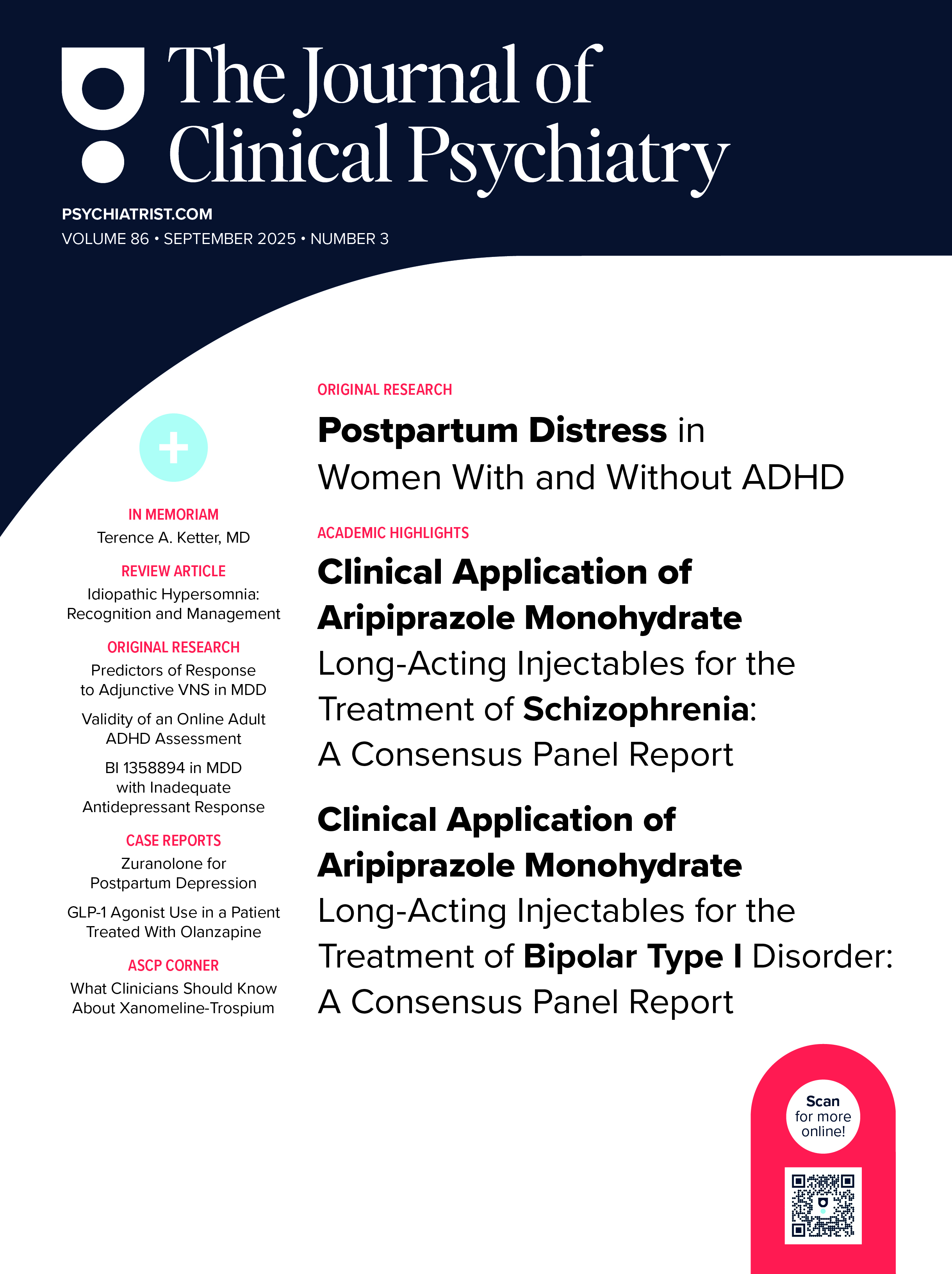Because this piece does not have an abstract, we have provided for your benefit the first 3 sentences of the full text.
To the Editor: In a comprehensive and elegant review on long-acting injectable antipsychotics (LAIs) published in a recent supplement to the Journal, Correll et al reported that "education about the potential benefits of LAIs should be provided to clinicians and the health care team." My colleagues and I agree with the authors that LAIs have been shown to reduce relapse compared to oral antipsychotics, but their prescribing patterns are not well known.
A recent study conducted in Canada by my colleagues and I investigated prescribing determinants of LAIs among physicians treating schizophrenia using the Quebec drug plan (Rשgie de l’ assurance maladie du Quשbec [RAMQ]) database.
This work may not be copied, distributed, displayed, published, reproduced, transmitted, modified, posted, sold, licensed, or used for commercial purposes. By downloading this file, you are agreeing to the publisher’s Terms & Conditions.
See letter by Stip, reply by Correll et al, and article by Correll et al
Physician Characteristics Associated With Prescription of Long-Acting Injectable Antipsychotics
To the Editor: In a comprehensive and elegant review on long-acting injectable antipsychotics (LAIs) published in a recent supplement to the Journal, Correll et al reported that "education about the potential benefits of LAIs should be provided to clinicians and the health care team."1(p17) My colleagues and I agree with the authors that LAIs have been shown to reduce relapse compared to oral antipsychotics, but their prescribing patterns are not well known.
A recent study conducted in Canada by my colleagues and I investigated prescribing determinants of LAIs among physicians treating schizophrenia using the Quebec drug plan (Régie de l’ assurance maladie du Québec [RAMQ]) database. The RAMQ database also includes information on the insured person, such as age, gender, and region, and information on the physicians, such as the period of graduation. Patients with schizophrenia who were incident users of an LAI between January 2008 and March 2012 were selected. Schizophrenia diagnoses were considered confirmed if the last diagnosis related to psychiatric diseases (ICD-9 codes 290.0-311.9) recorded in the database was one of schizophrenia (ICD-9 code 295.x).
In this study, 8,230 patients received at least 1 prescription for an LAI. Of these patients, 4,974 did not receive a prescription for an LAI in the year preceding index date (incident users). A total of 3,957 of them were covered by the RAMQ drug insurance for at least 1 year before and 1 year after index date. Finally, 1,996 patients were selected as patients with schizophrenia using an LAI. The general population consisted of a random sample of patients (N = 117,621) enrolled in the RAMQ database. Physician characteristics related to the prescription of the first LAI in the schizophrenia population and prescribing in the general population were compared using the χ2 test and with a base index of 100, where > 100 indicates an overrepresentation and < 100 indicates an underrepresentation in users with schizophrenia.
Prescribers of LAIs for schizophrenia were more likely to graduate in 1990-1999 (index = 153, P > .001) compared to 1970-1979 (index = 63, P < .001), more likely to practice in Montréal-Centre than in other areas of Quebec (index = 147, P > .001), and more likely to work in both inpatient and outpatient settings (index = 338 and index = 391, respectively, P > .001) compared to prescribers for the general population. Data also showed that the use of atypical LAIs compared to typical LAIs was significantly higher (P < .001) among younger prescribers (graduation = 1990), in contrast with a significantly higher (P < .001) use of typical LAIs among older prescribers (graduation = 1979). The degree of prescribing LAIs appeared to be heterogeneous across the province of Quebec.
In summary, LAI use was more common among recently graduated physicians and those in urban areas and working in both inpatient and outpatient settings.
Reference
1. Correll CU, Citrome L, Haddad PM, et al. The use of long-acting injectable antipsychotics in schizophrenia: evaluating the evidence. J Clin Psychiatry. 2016;77(suppl 3):1-24. PubMed doi:10.4088/JCP.15032su1
aDepartment of Psychiatry, Centre Hospitalier de l’ Université de Montréal; and Department of Psychiatry, H×´pital Notre-Dame-Pavillon L. C. Simard, Montreal, Quebec, Canada
Potential conflicts of interest: None.
Funding/support: RAMQ data were obtained with funding from Lundbeck and Otsuka Canada.
J Clin Psychiatry 2017;78(8):e1060
https://doi.org/10.4088/JCP.16lr11401
© Copyright 2017 Physicians Postgraduate Press, Inc.
This PDF is free for all visitors!





